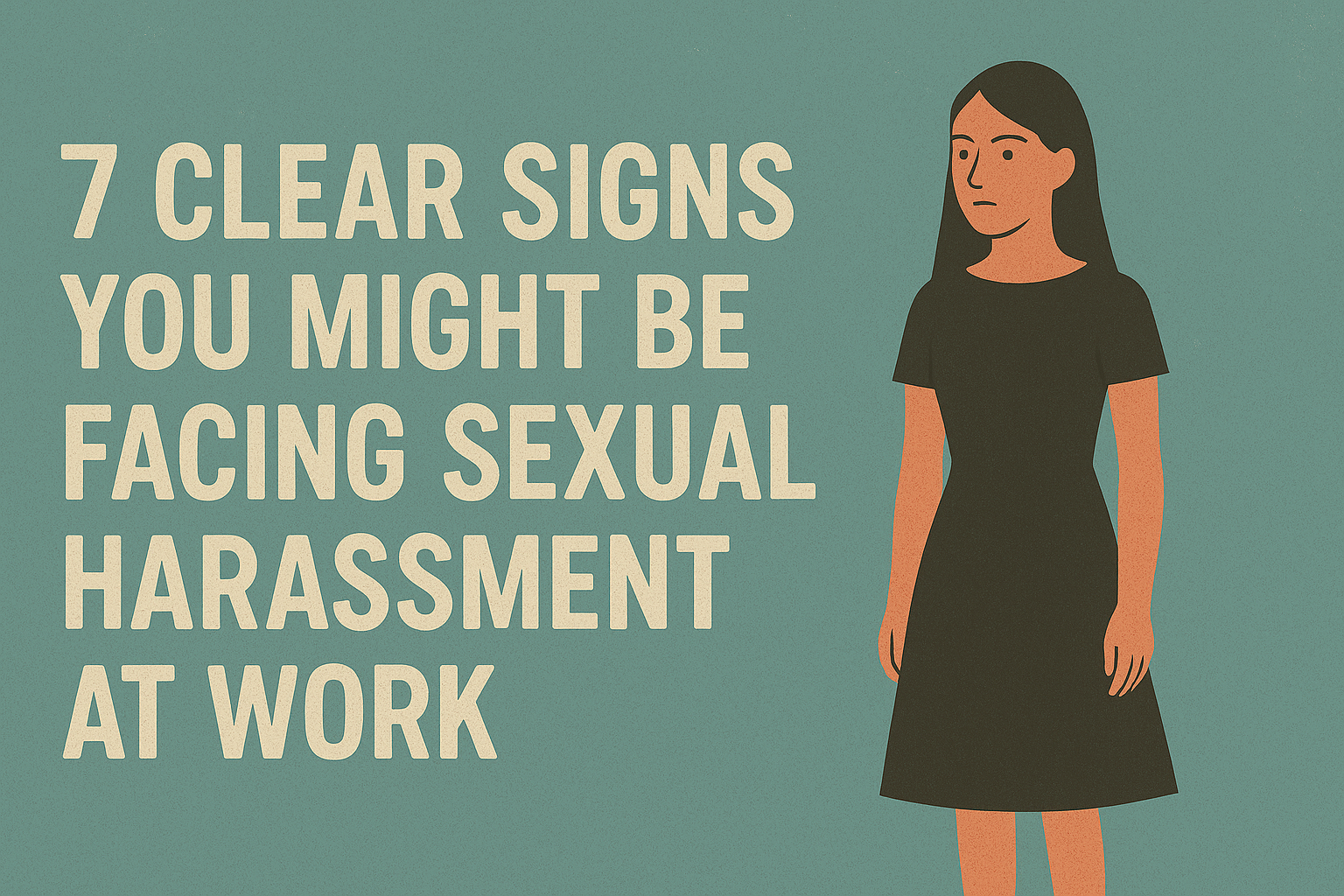The worst thing you can face at work is sexual harassment. Workplace misconduct isn’t always loud. Sexual harassment at work often hides behind sarcasm, selective invitations, or awkward silences after a team meeting. What seems like an offhand joke might actually be targeted behavior.
The shift to hybrid offices has made it easier for misconduct to slip through unnoticed, especially when it comes through private chats, late-night calls, or forced bonding during off-hours.
If you’ve ever second-guessed someone’s tone or felt uncomfortable but couldn’t explain why, this guide breaks down the early warning signs and what you can do about them.
7 Clear Signs You’re Facing Sexual Harassment
Not all harassment is explicit. Many people dismiss or ignore the early signs because they’re subtle, often disguised as humor, routine workplace behavior, or team bonding.
But these patterns, if left unchecked, can cause long-term psychological and professional harm. Below are some of the most common and overlooked signs of sexual harassment at work that you should take seriously.
1. Inappropriate “Jokes” or Comments About Appearance
It usually starts small with comments about your outfit, hairstyle, or body, often passed off as jokes. When these remarks are repeated or make you feel uneasy, it’s more than banter.
This is sexual harassment at work. It builds a hostile work environment and creates real psychological impact, especially when ignored or dismissed as “just teasing.”
2. Unwanted Physical Proximity or Touch
Standing too close during conversations, brushing against you in crowded areas, or lingering touches on the arm or back can all signal sexual harassment at work.
These actions often get excused as accidental, but if they happen often or make you uncomfortable, it’s a warning sign.
Such behavior contributes to a hostile work environment and can cause lasting emotional distress.
3. Sexualized Digital Communication
Private messages with flirty emojis, late-night texts, or memes with double meanings may seem casual at first. But when the content turns suggestive or personal without consent, it crosses the line into sexual harassment at work.
These patterns, especially over time, can create a hostile work environment and should be part of your documentation steps.
4. Exclusion from Opportunities After Rejection
If you’ve declined personal invitations and then notice being left out of meetings, projects, or decisions, that’s not coincidental.
It’s a subtle form of sexual harassment at work. When access or advancement is affected after setting boundaries, it reflects quid pro quo harassment and contributes to a toxic workplace culture rooted in retaliation.
Note: Quid pro quo harassment happens when a manager or someone with authority uses their position to pressure an employee into unwanted sexual conduct in return for job-related benefits. It could be as direct as offering a raise for compliance, or as subtle as hinting at consequences for saying no.
5. Pressure for Off-Hours Socializing
You’re repeatedly invited to dinners, drinks, or weekend plans that feel forced. These settings often blur lines, especially when someone adds flirtatious remarks or isolates you from the group.
When your refusal leads to colder treatment or fewer opportunities, it becomes sexual harassment at work. This kind of pressure breaks professional boundaries and fuels a hostile work environment.
6. Gaslighting About “Overreacting”
When you speak up about uncomfortable behavior and hear responses like “you’re being too sensitive” or “it was just a joke,” that’s gaslighting. It shifts the blame back onto you and makes you question your reaction.
This tactic is common in sexual harassment at work and reinforces a hostile work environment where concerns are dismissed instead of addressed.
7. Retaliation for Speaking Up
After filing a complaint or raising concerns, if you notice sudden micromanagement, exclusion from key tasks, or critical feedback that wasn’t there before, it’s likely retaliation.
This is a common response to reporting workplace misconduct and a serious violation of your rights. It reinforces fear, silences others, and deepens the psychological impact of sexual harassment at work.
Document every shift. It supports your case and helps trigger legal protections.
How to Respond Safely and Strategically
| # | Sign of Harassment | Action to Take | Why It Matters |
| 1 | Inappropriate jokes or comments | Write down exact words, dates, and reactions in a secure document | Builds a clear documentation step for verbal harassment and shows a pattern |
| 2 | Unwanted physical proximity or touch | Describe the physical contact in detail and note any witnesses | Physical actions carry legal weight and show a serious breach of boundaries |
| 3 | Sexualized digital communication | Save screenshots, timestamps, and all related chats | Creates strong digital evidence for reporting workplace misconduct under HR policies |
| 4 | Exclusion after rejection | Track changes in work assignments or access to opportunities | Shows signs of quid pro quo harassment and retaliation linked to personal boundaries |
| 5 | Pressure for off-hours socializing | Record invitations, especially if they come with consequences for saying no | Helps demonstrate a pattern of coercion tied to workplace dynamics |
| 6 | Gaslighting about “overreacting” | Note who said it, when, and in what context | Proves emotional manipulation and undermining behavior common in hostile work environments |
| 7 | Retaliation for speaking up | Keep a log of negative changes after reporting (e.g., reviews, exclusions) | Documents retaliation risks, supporting your case under workplace legal protections |
Recognizing sexual harassment at work is only the first step. What you do next matters just as much. Acting with clarity and caution can protect your mental health, your role, and your legal standing. Below are a few steps to help you respond without putting yourself at greater risk.
1. Document Everything (Including Digital Trails)
Start keeping detailed records from the moment something feels off. Save emails, screenshots, chat logs, and make notes of dates, times, and non-verbal cues.
Use any tool at your disposal to create a private timeline. Consistent documentation strengthens your case if you’re ever reporting workplace misconduct or facing retaliation risks.
2. Leverage Confidential Reporting Channels
If you don’t trust your internal team or feel unsafe going to HR, look for anonymous tools your company may offer. Some workplaces now use third-party platforms with built-in confidentiality protocols.
These allow you to report without direct exposure. It’s one way to speak up about sexual harassment at work without facing immediate retaliation risks.
Conduct by Ungender is one such platform that enables secure, anonymous reporting, guides you through documentation steps, and routes concerns to the right people—without exposing your identity. It’s designed for workplaces that want to take misconduct seriously, with a strong focus on data protection, legal compliance, and trauma-informed response.
3. Seek External Legal or Advocacy Support
If internal channels fail or feel unsafe, reach out to trusted organizations. Groups like the SHe-Box or local legal aid bodies offer guidance on reporting workplace misconduct and understanding your legal protections.
Speaking with an employment lawyer can also clarify your rights and help address retaliation risks linked to sexual harassment at work.
Ungender’s team of legal and compliance experts has supported thousands of individuals and organizations through investigations and workplace culture reform. If you’re unsure of your next step, we can help guide you confidentially—whether it’s advice, redressal, or understanding your rights.
Preventing Retaliation: Your Rights
Once you’ve taken steps to report sexual harassment at work, the fear of backlash is real. Retaliation often doesn’t show up as open hostility. It can take subtle forms like changes in tone, responsibilities, or how others include you in daily tasks.
Knowing your rights helps you stay one step ahead. Here’s how to recognize the signs and act without delay.
1. How to Spot Retaliation
Retaliation isn’t always loud or immediate. It might begin with reassigned tasks, fewer client-facing roles, or being excluded from informal updates. Over time, these changes isolate you and affect your growth.
If these shifts occur after reporting workplace misconduct, take them seriously. Retaliation erodes trust and compounds the psychological impact of sexual harassment at work. Stay alert and begin tracking changes early.
2. Legal Recourse if Retaliated Against
If you face retaliation after raising a concern or filing a complaint of sexual harassment at work, you’re not without support. Under the POSH Act, 2013, any negative action taken against you for reporting harassment, like exclusion from projects, sudden poor reviews, or increased micromanagement, is not allowed.
You can take the matter to your organization’s Internal Committee. If that doesn’t resolve it, you can consult a lawyer to explore legal options under other laws.
Retaliation goes against the purpose of POSH and can lead to serious consequences for the employer under both internal policies and Indian law.
Conclusion
You’re not imagining it, and you’re not overreacting. If something feels wrong, it’s okay to trust that feeling.
Sexual harassment at work can be confusing and make you feel alone, but you are not. Many people have gone through this and found safe ways to speak up and take action. You don’t need to fix everything at once.
Start by writing things down, talk to someone you trust, and reach out for help if you need it. You deserve to feel safe and respected at work. You’re not asking for too much.
If your workplace has partnered with Conduct by Ungender, you can use it to report concerns anonymously, seek guidance, and track your documentation securely. And if you’re not sure where to begin, Ungender offers confidential support and advisory services to help you take the first step.
People also asked
1. What exactly qualifies as sexual harassment at work?
Sexual harassment at work includes unwelcome physical contact, verbal harassment, suggestive messages, or demands tied to job benefits. It creates a hostile work environment that affects your well-being or performance. No one should tolerate it. If it makes you uncomfortable, it’s valid. Start documenting steps and seek help.
2. Can men also file a complaint of sexual harassment in a workplace?
Yes, men can file a complaint of sexual harassment at work. While the PoSH Act, 2013 in India currently protects women specifically, men can still seek justice through company HR policies, internal complaint mechanisms, or file a case under other applicable laws like IPC Section 354A. Reporting workplace misconduct is every employee’s right, regardless of gender. If you’re facing verbal harassment, non-verbal cues, or any inappropriate behavior, document it and speak up. You are not alone, and your experience is valid.
3. What should I do if I experience sexual harassment at work?
Start with clear documentation steps. Save emails, note incidents, and observe non-verbal cues. Then report it using internal or anonymous channels. If ignored, contact legal or advocacy support. Sexual harassment at work is not something you have to tolerate. Speaking up is hard but necessary. You are protected.
4. What if the harassment occurs outside of the workplace?
Harassment doesn’t have to happen inside an office to be considered workplace misconduct. If it happens during a work trip, at an office party, in a virtual meeting, or through work-related messages, it still counts.
The setting doesn’t change the fact that it’s connected to your job. These situations often get ignored, especially when they happen outside regular work hours or in digital spaces. But your rights don’t stop at the office door.
If something feels off, start documenting and speak up through the right channels.
5. Can I be retaliated against for reporting sexual harassment?
Retaliation after reporting workplace misconduct is illegal. If you face micromanagement, exclusion, or poor reviews, those are retaliation risks. Keep documenting. You are protected under law and support exists. Reporting sexual harassment at work takes courage. Your safety should never be compromised for speaking up.
6. What if there are no witnesses to the harassment?
You do not need witnesses to prove sexual harassment at work. Keep digital evidence, note dates, and track non-verbal cues. These records support your case. Your experience is real and your voice matters. Many go through this quietly. Take the first step and know you are not alone.
7. Is a single incident enough to constitute sexual harassment?
Yes. Even a single incident, if severe or impactful enough, such as unwanted physical contact, explicit sexual remarks, or threats, can amount to sexual harassment under the POSH Act. The law does not require repeated behavior for an act to be taken seriously. If something feels wrong, start documenting it and reach out to the Internal Committee or a trusted resource. One instance is enough to take action.
8. How long do I have to file a complaint about sexual harassment?
Under the POSH Act, 2013, a complaint of sexual harassment at the workplace should be filed within three months from the date of the incident. If there are multiple incidents, the timeline is counted from the date of the last occurrence. This time limit can be extended by another three months if the Internal Committee or Local Complaints Committee finds the delay justified. It’s important to start documenting your experience early and reach out for support without waiting. Acting sooner helps your case and ensures a timely response. You have rights, and you’re not alone in this process.








